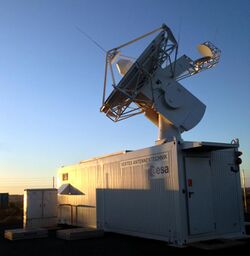Organization:New Norcia Station
New Norcia Station (also known as NNO) is an ESTRACK Earth station in Australia for communication with spacecraft after launch, in low Earth orbit, in geostationary orbit and in deep space. It is located 10 kilometres (6.2 mi) south of the town of New Norcia, Western Australia.[1] It was the first ESA deep space ground station,[2] followed by Cebreros Station and Malargüe Station.
The station operates a 35-metre dish designated NNO-1[3] capable of two-way transmission in both S- and X-bands using 2 and 20-kilowatt transmitters. The antenna weighs over 600 tonnes and is 40 metres tall. Future upgrade plans include adding a Ka-band station to support international missions.[1]
New Norcia Station was one of the stations providing communications, tracking and data download from the Rosetta spacecraft.[4] It supports the BepiColombo mission.[1]
History
Construction began in April 2000 and lasted until the end of the first half of 2002. Installation of electronics and communication equipment followed. The station was officially opened on 5 March 2003 by the Premier of Western Australia at the time, Dr Geoff Gallop. Total construction cost was €28 million.[2]
In December 2019, ESA announced plans to build a second 35 metre deep space antenna at New Norcia[5] to provide coverage for upcoming ESA missions, including Solar Orbiter, Hera, and Jupiter Icy Moons Explorer. This is due for completion in late-2024. The antenna is due to enter operation in early-2025.
Since June 2019, operational support and maintenance of the station has been the responsibility of CSIRO.
NNO-2
A new 4.5-metre dish designated NNO-2 was inaugurated on 11 February 2016.[6] NNO-2 acts as an acquisition aid for the 35-metre dish for fast-moving satellites and launch vehicles during their launch and early orbit stage.
The NNO-2 mount is capable of tracking at 20 degrees per second in azimuth and 10 degrees per second in elevation.
The 4.5-metre dish has a half-power beam width of 1.9 degrees at S-band and 0.5 degrees at X-band and can be used to communicate with spacecraft up to 100,000 kilometres in altitude. To help in signal acquisition when the spacecraft position is too uncertain, the 4.5-metre dish has a 0.75-metre dish piggy-backed onto it, with a half-power beam width of 3.5 degrees at X-band. There is no S-band capability on the 0.75m dish.
NNO-2 may also be operated independently of NNO-1, as it commonly does during support activities for launches of Ariane 5, Vega, and Soyuz rockets from the Guiana Space Centre.
References
- ↑ 1.0 1.1 1.2 "New Norcia - DSA 1". ESA. http://www.esa.int/Our_Activities/Operations/New_Norcia_-_DSA_1.
- ↑ 2.0 2.1 "ESA's first deep space ground station opens in Western Australia". ESA. 3 March 2003. http://www.esa.int/About_Us/Welcome_to_ESA/ESA_s_first_deep_space_ground_station_opens_in_Western_Australia.
- ↑ "Find ESA tracking stations". ESA. http://www.esa.int/Our_Activities/Operations/Find_ESA_tracking_stations.
- ↑ "What's up with Rosetta?". ESA. 18 August 2014. http://blogs.esa.int/rosetta/2014/08/18/whats-up-with-rosetta/.
- ↑ "ESA to Peer into Deep Space with New Antenna". Asgardia Space. 13 December 2019. https://asgardia.space/en/news/ESA-to-Peer-into-Deep-Space-with-New-Antenna.
- ↑ "New antenna ready for business". ESA. http://www.esa.int/Our_Activities/Operations/Estrack/New_antenna_ready_for_business.
External links
- Talking to Satellites in Deep Space from New Norcia, chapter from ESA Bulletin, May 2003.
- Europe’s Access to Deep Space: The Deep Space Ground Station in Australia
 |




